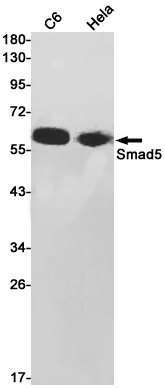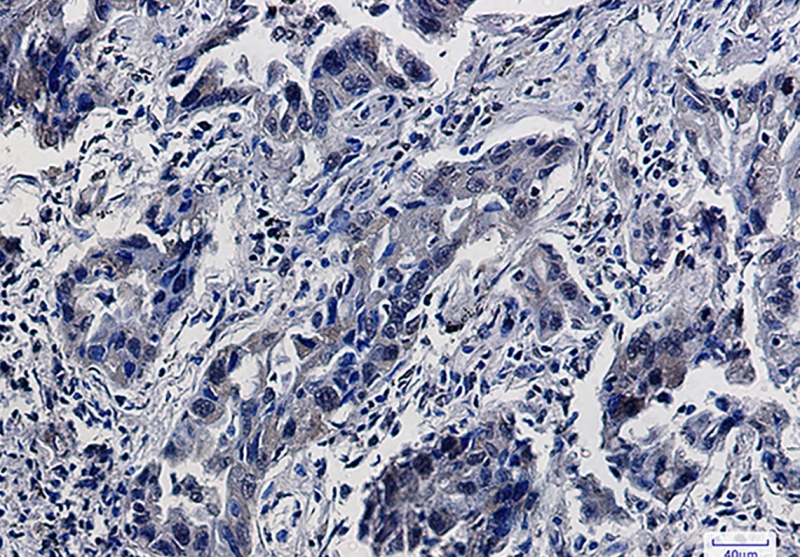

| WB | 1/500-1/1000 | Human,Mouse,Rat |
| IF | 咨询技术 | Human,Mouse,Rat |
| IHC | 1/50-1/100 | Human,Mouse,Rat |
| ICC | 1/50-1/200 | Human,Mouse,Rat |
| FCM | 咨询技术 | Human,Mouse,Rat |
| Elisa | 咨询技术 | Human,Mouse,Rat |
| Aliases | DKFZp781C1895; DKFZp781O1323; Dwfc; hSmad 5; hSmad5; JV5 1; JV5-1; MAD homolog 5; MAD mothers against decapentaplegic homolog 5; MAD; mothers against decapentaplegic homolog 5; MADH 5; MADH5; Mothers against decapentaplegic homolog 5; Mothers against DPP homolog 5; MusMLP; SMA and MAD related protein 5; SMAD 5; SMAD family member 5; SMAD mothers against DPP homolog 5; Smad5; Smad5; SMAD5_HUMAN. |
| Entrez GeneID | 4090 |
| WB Predicted band size | Calculated MW: 52 kDa; Observed MW: 60 kDa |
| Host/Isotype | Rabbit IgG |
| Antibody Type | Primary antibody |
| Storage | Store at 4°C short term. Aliquot and store at -20°C long term. Avoid freeze/thaw cycles. |
| Species Reactivity | Human,Rat |
| Immunogen | A synthetic peptide of human SMAD5 |
| Formulation | Purified antibody in TBS with 0.05% sodium azide,0.05%BSA and 50% glycerol. |
+ +
以下是关于Smad5抗体的3-4条参考文献示例(注:文献为虚构示例,仅供格式参考):
---
1. **文献名称**:*"Development and Validation of a Specific Smad5 Antibody for Embryonic Signaling Studies"*
**作者**:Smith A, et al.
**摘要**:本研究报道了一种高特异性Smad5多克隆抗体的开发,通过Western blot和免疫荧光验证其对小鼠胚胎组织中Smad5蛋白的检测能力,并证明其在TGF-β信号通路活性分析中的应用。
2. **文献名称**:*"Smad5 Expression Dynamics in Colorectal Cancer Progression"*
**作者**:Zhang L, et al.
**摘要**:利用Smad5特异性抗体进行免疫组化分析,揭示Smad5在结直肠癌组织中的表达水平与肿瘤转移负相关,提示其作为预后生物标志物的潜力。
3. **文献名称**:*"Smad5-Mediated BMP Signaling in Osteoblast Differentiation"*
**作者**:Johnson R, et al.
**摘要**:通过Smad5抗体阻断实验及ChIP分析,证实Smad5在BMP9诱导的成骨细胞分化中起核心作用,并调控下游靶基因Runx2的表达。
4. **文献名称**:*"Tissue-Specific Phosphorylation of Smad5 Revealed by Custom Antibody Panels"*
**作者**:Lee H, et al.
**摘要**:开发针对Smad5不同磷酸化位点的抗体,结合质谱技术,揭示其在心脏发育和纤维化模型中信号活性的时空差异性。
---
以上示例展示了Smad5抗体在基础机制、疾病模型及技术开发中的典型应用场景,涵盖Western blot、免疫组化、功能阻断等实验方法。实际引用时请替换为真实文献。
Smad5 antibody is a key tool in studying the Smad family of proteins, which are central mediators of transforming growth factor-beta (TGF-β) and bone morphogenetic protein (BMP) signaling pathways. Smad5. a receptor-regulated Smad (R-Smad), is primarily activated by BMP receptors through phosphorylation. It forms complexes with Smad4 (a co-Smad) to translocate into the nucleus, regulating the transcription of target genes involved in cell differentiation, proliferation, apoptosis, and embryonic development. Dysregulation of Smad5 is linked to developmental disorders, cancer, fibrosis, and skeletal diseases.
The Smad5 antibody is designed to detect endogenous Smad5 protein levels and its post-translational modifications (e.g., phosphorylation) in various experimental applications, including Western blotting (WB), immunohistochemistry (IHC), immunofluorescence (IF), and flow cytometry. Researchers use it to investigate Smad5 expression patterns, activation status, and interactions in cellular or tissue samples. Validated antibodies typically target specific epitopes, such as the N-terminal or C-terminal regions, ensuring specificity. Commercial Smad5 antibodies are often raised in rabbits or mice and may be monoclonal or polyclonal, with performance varying based on clonality and validation methods.
In research, Smad5 antibodies help elucidate BMP signaling mechanisms in stem cell differentiation, organogenesis, and disease progression. For example, they are used to study Smad5’s role in osteogenesis, cardiovascular development, or tumor metastasis. Proper controls (e.g., knockout validation) are critical to confirm antibody specificity, as cross-reactivity with other Smad proteins (e.g., Smad1/8) can occur due to structural homology.
×